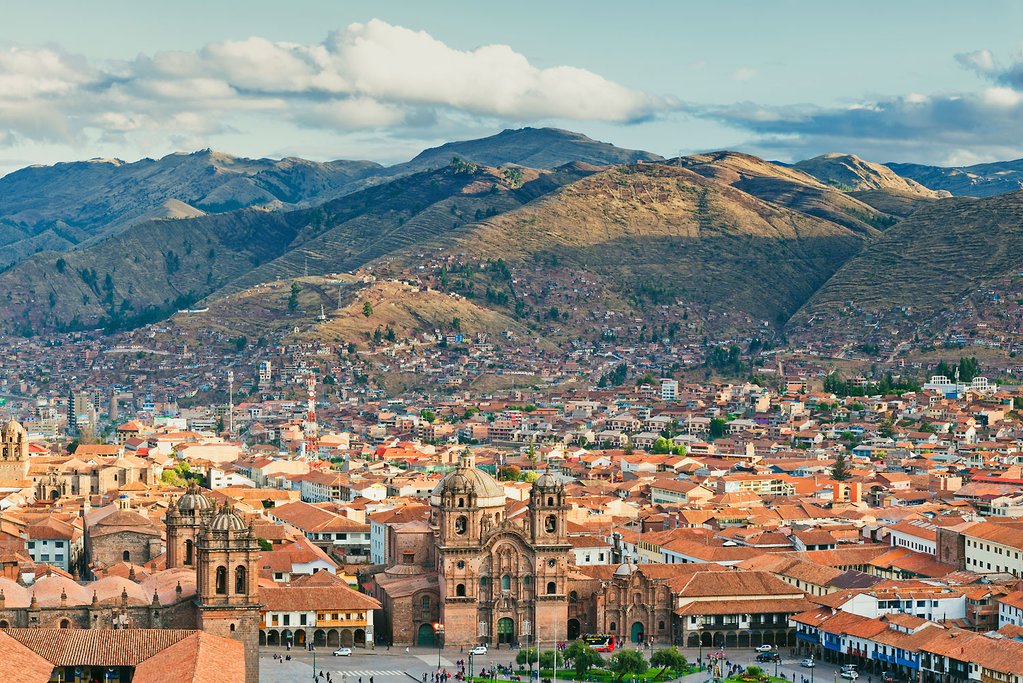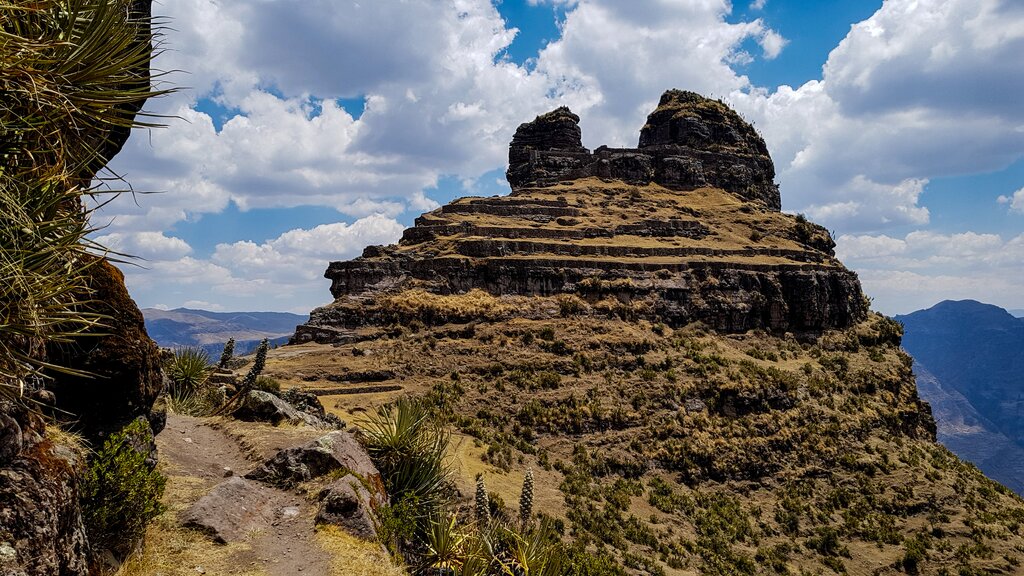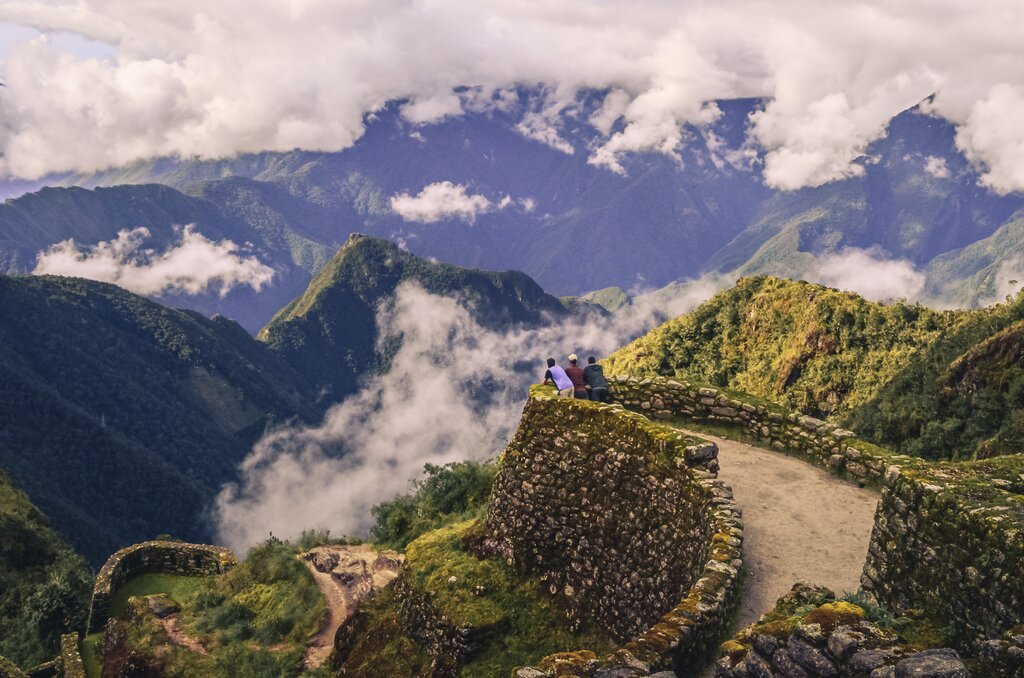Highlights
- Experience the pulsing nightlife of Lima's Miraflores district
- See the mysterious Karajia Sarcophagi
- Marvel at the engineering feat of Machu Picchu
- Hike to one of the world's largest waterfalls in Gocta
Brief Itinerary
| Day | Highlights | Overnight |
|---|---|---|
| Day 1 | Arrive in Lima | Lima |
| Day 2 | Fly to Trujillo, Guided Walking Tour | Trujillo |
| Day 3 | El Brujo Monuments in Chicama Valley | Trujillo |
| Day 4 | Bus to Chiclayo, Museum of Royal Tombs | Chiclayo |
| Day 5 | Explore Chiclayo & Valley of the Pyramids | Chiclayo |
| Day 6 | Fly to Jaen, Explore Jaén | Jaén |
| Day 7 | Transfer to Chachapoyas, Karajia Sarcophagi | Chachapoyas |
| Day 8 | Guided Kuélap Archaeological Site Tour | Chachapoyas |
| Day 9 | Hike to Gocta Waterfalls, Drive to Jaén | Jaén |
| Day 10 | Fly to Cusco, Explore | Cusco |
| Day 11 | Transfer to Pitumarca, Hike to Waqrapukara | Waqrapukara |
| Day 12 | Guided Waqrapukara Tour, Transfer to Caicay | Caicay |
| Day 13 | Explore Sacred Valley & Pisac, Train to Aguas Calientes | Aguas Calientes |
| Day 14 | Machu Picchu & Travel to Cusco | Cusco |
| Day 15 | Explore Cusco, Depart |
Detailed Itinerary
Day 1: Arrive in Lima

Welcome to Lima! Peru's largest city and central metropolitan hub, and home to one-third of the country's population. Your driver will meet you in the arrivals at the airport hall and take you to your hotel. This city is the site of a pre-Columbian Indigenous Ychsma settlement—conquered by the Inca empire in the 15th century and later by the Spanish conquistadors—and it has a fascinating history and a diverse mix of cultures. See the Amerindian, European, Afro-Peruvian, and Asian (mainly Chinese and Japanese) influences in the food and neighborhoods across the city.
Settle into your hotel and then set off for a walk to discover the city. With an eclectic mix of culinary styles, there is no shortage of diverse dining options. After dinner, or while exploring, see Lima's 16th-century cathedral, which took 80 years to construct, and then head to Love Park in the upscale Miraflores district to admire its huge kissing statue and mosaic walls. Walk along the water, watch the sunset, and see where the night takes you.Day 2: Fly to Trujillo, Guided Walking Tour

After breakfast in Lima, head for the airport with a private driver to catch an approximately one-hour flight north to Trujillo. Trujillo was the first capital of Peru, following the country's emancipation from Spain. There's a lot of history to discover on a walking tour with a local guide upon your arrival.
At Plaza de Armas, see Liberty Monument, built in 1929 to mark Trujillo's and Peru's 1820 independence from Spain. Step inside the 17th-century Trujillo cathedral and go back in time with a tour of a few colonial mansions. At Garci Holguin, see murals, and then at Urquiaga House, learn about its past, including its connection to former Venezuelan president Simón Bolívar. Stroll Pizarro promenade, and visit 17th-century La Merced Church and the Emancipation House, where José Bernardo de Tagle declared Trujillo's independence. At 19th-century Iturregui Palace, learn about neoclassical civil architecture.
End the tour at Recreo Plaza to relax and eat lunch.
Day 3: El Brujo Monuments in Chicama Valley

After breakfast, get ready to learn about another chapter of Peru's history at El Brujo ("the sorcerer")—an ancient archaeological complex in Chicama Valley about one hour north of Trujillo. Here, see huacas (monuments), including Huaca Prieta, Huaca El Brujo, and Huaca de Cao, and learn about the various cultural practices that led to their creation, including their murals and intricate base reliefs depicting the area's former warrior culture.
At Cao Museum, see Lady of Cao, whose tomb was discovered in 2006. A Moche mummy, she is covered in tattoos, was found buried with weapons and jewelry and was likely a high priestess or Moche ruler. After learning about Peru's ancient civilizations, go back to your Trujillo hotel and find another place to go out for the evening.Day 4: Bus to Chiclayo, Museum of Royal Tombs

After breakfast, take a bus from Trujillo to Chiclayo, where you'll spend the next two nights, traveling about four hours north. The capital of the Lambayeque region is known for its archaeological sites, parks, gardens, and beaches.
Chat with a local specialist who can help organize your trip.
Day 5: Day Trip to Túcume & Valley of the Pyramids

Túcume is known as the Valley of the Pyramids because it was the capital of the kingdom of Lambayeque in Peru's pre-Hispanic rule era. It is the site of 26 huacas, the first residential palaces, and then the center of administrative political power for the Chimu and Inca civilizations.
At Túcume Museum, see 16th-century chapels and artifacts from Lambayeque, Chimu, and Inca, and learn about their customs. From the museum, explore Túcume's major pyramids: Huaca las Estacas, Huaca el Mirador, and Huaca Larga. Take extra time to explore Huaca Larga—the largest pyramid on site that was a significant Inca center of worship. After a full day of an immersive history lesson, go back to your Chiclayo hotel to rest and prepare for the next leg of the trip.Day 6: Fly to Jaen, Explore

After breakfast, transfer to Chiclayo airport for a flight north, traveling about one hour to Jaén. The city is in the high jungle of Northern Peru and is known for its coffee and archaeological museum.
Take the day to explore and discover the city with a local guide or on your own. At Jaén's Plaza de Armas, visit a cathedral and its statue of the Lord of Huamantanga, the city's patron saint. At Hermogenes Mejia Solf Regional Museum, see local arts and artifacts to learn more about the civilizations of Peru's past. Or, for a break from sightseeing, travel outside the city to explore a botanical garden with more than 600 varieties of regional plants and then enjoy dinner at a local restaurant.
Day 7: Transfer to Chachapoyas, Karajia Sarcophagi

After an early breakfast, set off for Chachapoyas, traveling about four hours south. This is where you'll see the Karajia Sarcophagi, a mysterious archaeological site in Carajía in the Utcubamba Valley, 29 miles (48 km) northwest of Chachapoyas.
During a two-hour site tour, you'll learn about the seven clay coffins in human body shapes. Inside these coffins on a cliffside are Chachapoyas mummies from the 15th century—a time before the Inca conquest. Learn about Chachapoyas' funeral rites and traditions from these figures known locally as "ancient wise men." After your tour, spend the evening at Chachapoyas.
Day 8: Guided Kuélap Archaeological Site Tour

Kuélap is an archaeological site with approximately 550 structures remaining from a Chachapoyas fortress, known as "Warriors of the Clouds." It gets its name from its location on a ridge overlooking the Utcubamba Valley at 9,800 feet (3,000 m) above sea level.
To get there, start with a two-hour drive to Kuélap from Chachapoyas, setting off in the morning. Then take a cable car up to the site, where a guide will teach you about some of the buildings across this 14-acre (6 ha) area, such as Major Temple and El Torreón ("the Tower"). Most structures were built between the 10th and 12th centuries, while the fortress was discovered in the 19th century. After the tour, go back to Chachapoyas for dinner and to rest at your hotel.
Day 9: Hike to Gocta Waterfalls, Transfer to Jaén

Get ready to explore Peru's natural beauty after breakfast and an hour's drive north. After the drive, set off on a 6-mile (9 km) hike to Gocta Waterfalls—one of the highest waterfalls in the world at 2,500 feet (771 m). During the hike, see the area's diverse landscape, including sugar cane crops and trapiches (mills). Then, approach a cloud forest and see trees covered with orchids, lichen, and moss, and keep an eye out for gallito de las rocas, Peru's national bird.
When you reach the waterfalls, your guide will reveal more about this once-secret place. For centuries, Gocta's location was hidden based on a legend that a mermaid protecting its waters would curse those who explained how to reach it. Enjoy views of this "mythical" cascade and take a chance to catch your breath. At the end of the hike, travel four hours north to Jaén, where you'll spend the night before traveling to Cusco tomorrow.
Day 10: Fly to Cusco, Explore

After breakfast in Jaén, you'll transfer to the airport and catch an approximately four-hour flight south to Cusco. In Cusco, settle into your hotel and then get out and explore the former Inca capital. As Cusco is at 11,000 feet (3,352 m) above sea level, the air might feel thin, so take it easy and remember to drink a kit of water. Since Cusco was designed as a walking city, start your exploration of its narrow stone alleyways on foot, beginning with Plaza de Armas, sitting on one of its balconies to have a cup of coca tea while adjusting to the elevation.
Visit Cusco Cathedral, built from 1560 to 1654, and then discover Puca Pucara ruins, an architectural complex with plazas, baths, aqueducts, walls, and towers that were formerly used by the Inca emperor's staff while he stayed at Tambomachay—an elaborate estate with baths nearby. Explore the hilly San Blas neighborhood, a bohemian area with an artisan community. Then, eat an authentic Peruvian dinner, sampling dishes such as crackling pork, pickled vegetables, and hearth-baked bread.
Day 11: Transfer to Pitumarca, Hike to Waqrapukara

Get an early start today as you'll transfer by car 95 miles (153 km) south from Cusco to Pitumarca. From Pitumarca, begin a trek to Waqrapukara archaeological site. The first part of the hike is easy to acclimate to the park's 13,580 feet (4,150 m) altitude.
Appreciate the landscapes before reaching Yanacocha Lagoon for lunch, followed by a descent to Waqrapukara, an area to see alpacas, vicuñas, and Andean geese, and notice how large animallike formations mark the landscape. After an hour-long trek, arrive at Waqrapukara to set up camp for the night, eat dinner over a campfire, and sleep under the stars.
Day 12: Guided Waqrapukara Tour, Transfer to Caicay

After breakfast at the camp, a guide will lead you on a two-hour tour of Waqrapukara to learn about this Inca site's architecture, history, and legends. The mountaintop stone buildings here face Apurímac Canyon, and there is also an Inca cemetery and other remnants of Inca civilization.
From Waqrapukara, travel to Wayxi and then to the small town of Caicay for the night.
Day 13: Explore Sacred Valley & Pisac, Train to Aguas Calientes

In the morning, you'll approach the Sacred Valley, with its historical and archaeological sites, small towns, and textile markets. Pisac is the first stop, known for its artisan wool weavers. Learn how craftspeople clean and harvest wool, and create intricate designs with great attention to detail. After a demonstration, you might like to pick a creation to take home with you. Pisac also has a few Inca ruins on a hill at the entrance to a valley. See Inti Watana and its Temple of the Sun, with baths, altars, water fountains, and a ceremonial platform.
From Pisac, travel about one hour west to Ollantaytambo station, and board the scenic train to Aguas Calientes—the base to reach Machu Picchu. As you ride the train with its rooftop windows, take in the scenery of Andean landscapes and dense cloud forests moving along the Urubamba River. Go to sleep early at your Aguas Calientes hotel to get ready for an early departure in the morning to visit Machu Picchu.
Day 14: Explore Machu Picchu, Transfer to Cusco

Awake in Aguas Calientes and catch a bus before dawn for the 25-minute ride up to Machu Picchu. The 15th-century Inca citadel at 7,970 feet (2,430 m) is a masterpiece of engineering that was once a sanctuary and retreat for Inca Emperor Pachacutec and his royal court. Its name translates to "Old Mountain" in Quechua, and it was known to have housed 800 people. Machu Picchu was abandoned 100 years after its construction due to Spanish conquest and was largely hidden until the early 20th century.
Follow a guide learning about the major buildings and monuments, like Temple of the Condor, Temple of the Sun, and the Intihuatana sundial, used to predict the solstice. After the tour, take the bus back to Aguas Calientes, then switch to a train to Ollantaytambo, and transfer to your Cusco hotel.
Day 15: Explore Cusco, Depart

More great Peru itineraries
Looking for more inspiration for your trip to Peru? Check out these other Peru itineraries, explore different ways to spend 15 days in Peru, or discover the best time to visit Peru.


